To help answer that, we’ve dissected internet marketing into its most basic strategies. We’ve also simplified them so you can get started right away.
In this article, we’ll cover 11 internet marketing strategies that work:
- Search engine optimization
- Content marketing
- PPC marketing
- Email marketing
- Affiliate marketing
- Influencer marketing
- Video marketing
- Social media marketing
- Podcasting
- Conversion rate optimization
- Reputation management
Search engine optimization (SEO) is the practice of optimizing a website or webpage to increase the quantity and quality of its traffic from a search engine’s organic results. When your pages rank high on the search engines and maintain their positions, you can get almost free, passive traffic to your website consistently.
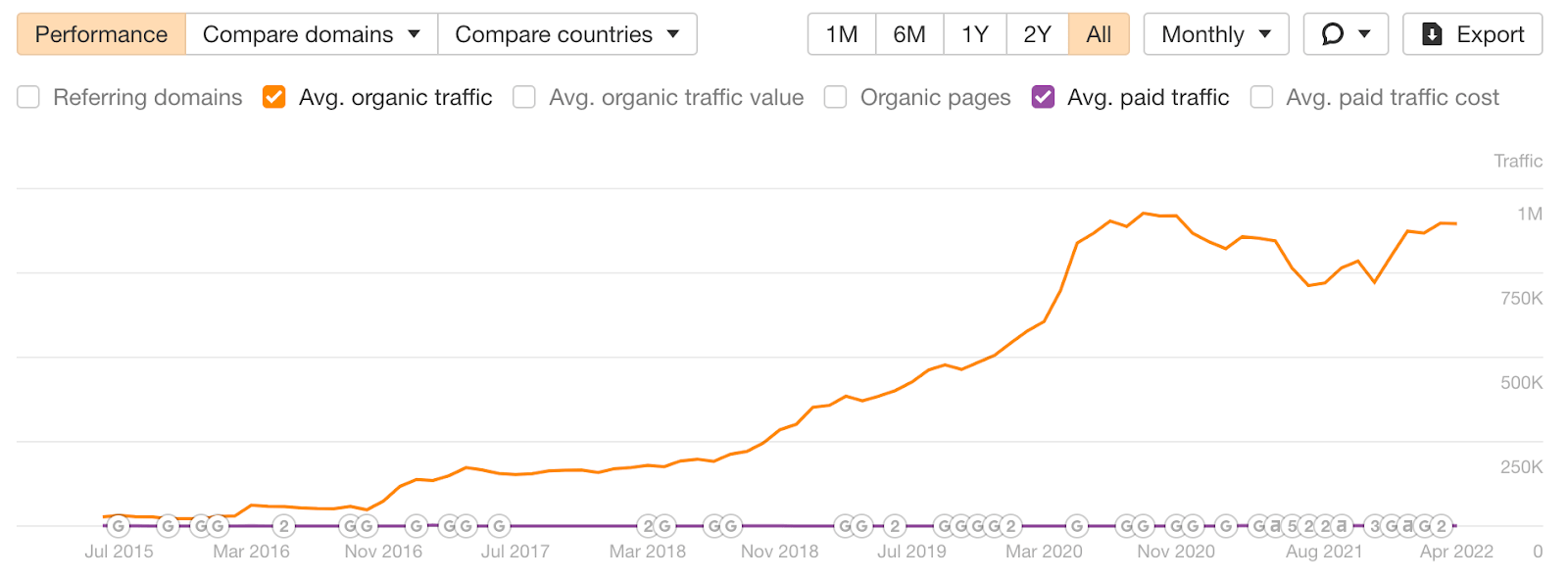
The amount of monthly organic traffic coming to Ahrefs.
How to do it
If you want to rank high on search engines, you have to target topics that your audience is searching for. Finding what these topics are is a process known as keyword research, and the easiest way to begin is to use a keyword research tool like Ahrefs’ Keywords Explorer.
Here’s how:
- Go to Ahrefs’ Keywords Explorer
- Enter one or a few terms relevant to your website or niche (e.g., if you sell coffee equipment, then you may want to enter keywords like coffee, french press, cappuccino, etc)
- Go to the Matching terms report
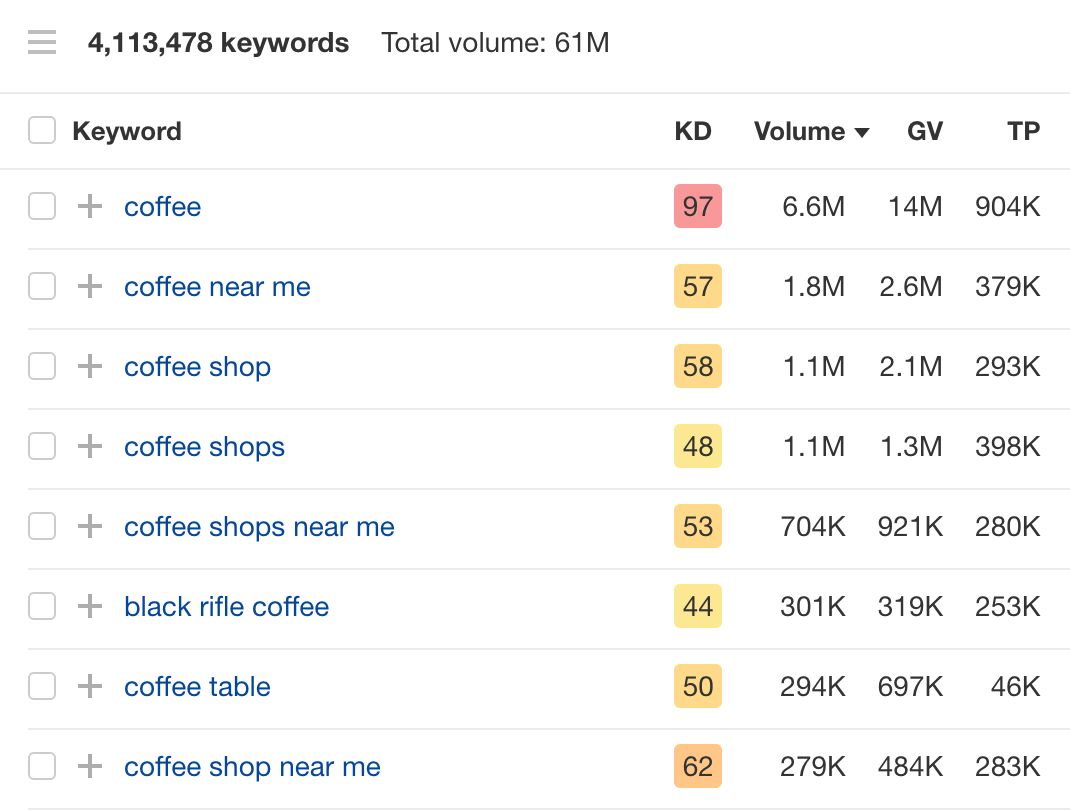
From here, you’ll want to look through the list and pick out relevant topics you wish to target. Generally speaking, the “ideal” keywords are those with high Traffic Potential (TP) and low Keyword Difficulty (KD).
You can use the filters to quickly narrow down such topics.

Then you’ll want to create a page that deserves to rank for that keyword. There are a few aspects to this process. But the most important part is to figure out why searchers are looking for that topic. This is known as search intent.
You can do this by looking at what’s currently ranking on the search engine results pages (SERPs) for your topic. For example, if we’re targeting the topic “best frying pans,” we’ll see that most of the top-ranking pages are blog posts about the best non-stick frying pans.
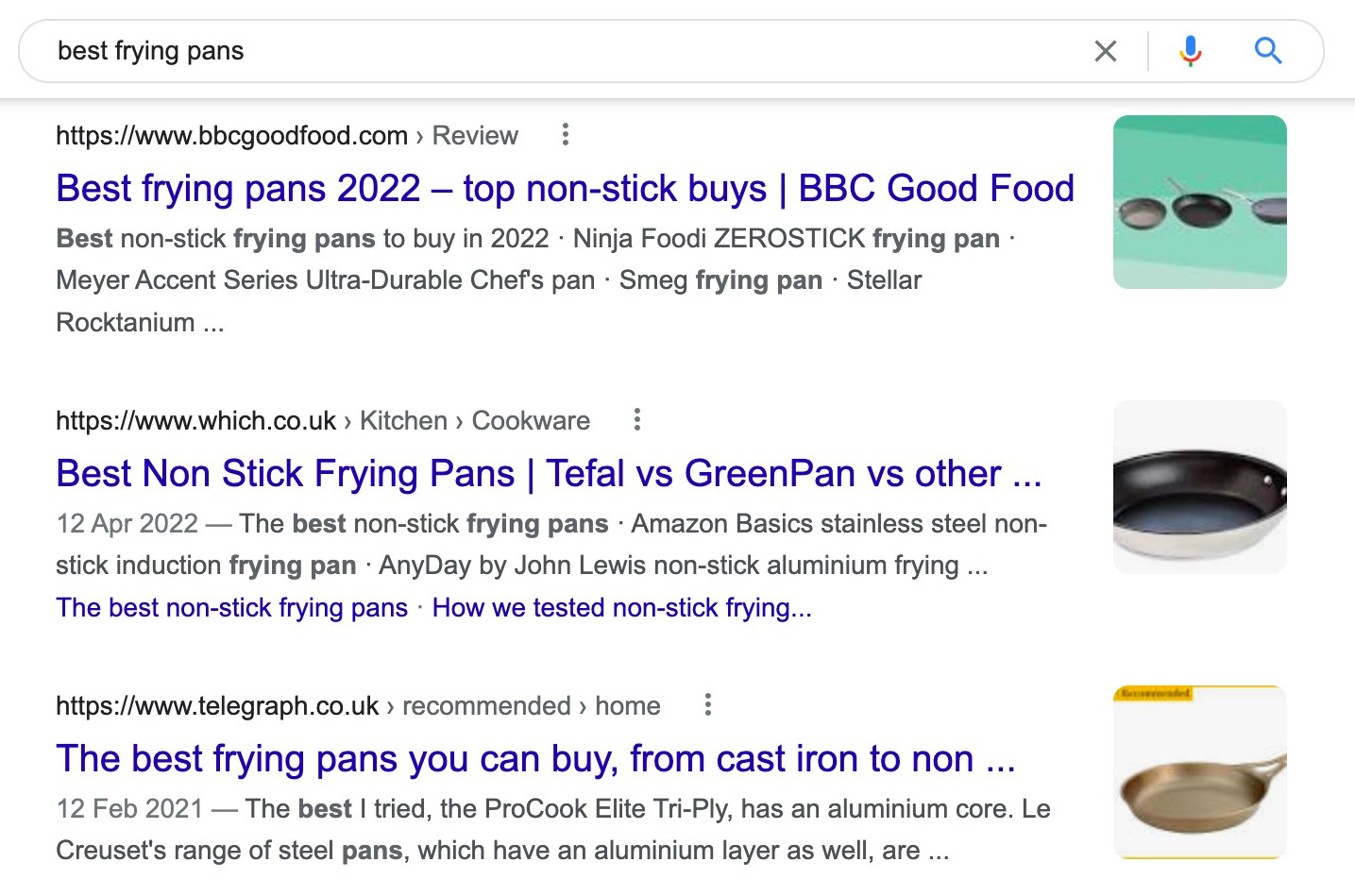
If we want to rank for this keyword, we’ll likely have to follow suit.
Once you’ve created and published that page, you’ll have to build links because they’re an important Google ranking factor. There are many ways to get backlinks, so I recommend reading our guide to link building.
Finally, you’ll want to make sure you get the technical aspects of your website right. (After all, if Google can’t find and index your pages, it can’t rank them on the SERPs.) The easiest way is to run an audit of your website with Ahrefs’ Site Audit. You can do this for free using Ahrefs Webmaster Tools.
Recommended reading: SEO: The Complete Guide for Beginners
Content marketing is the process of creating and distributing content to attract and retain customers.
How to do it
To get started, fill in the content strategy canvas. Your goal is to answer five simple questions:
- Who are you creating content for?
- Why are you creating content?
- What type of content will you create?
- Where will you publish the content?
- How will you create the content?
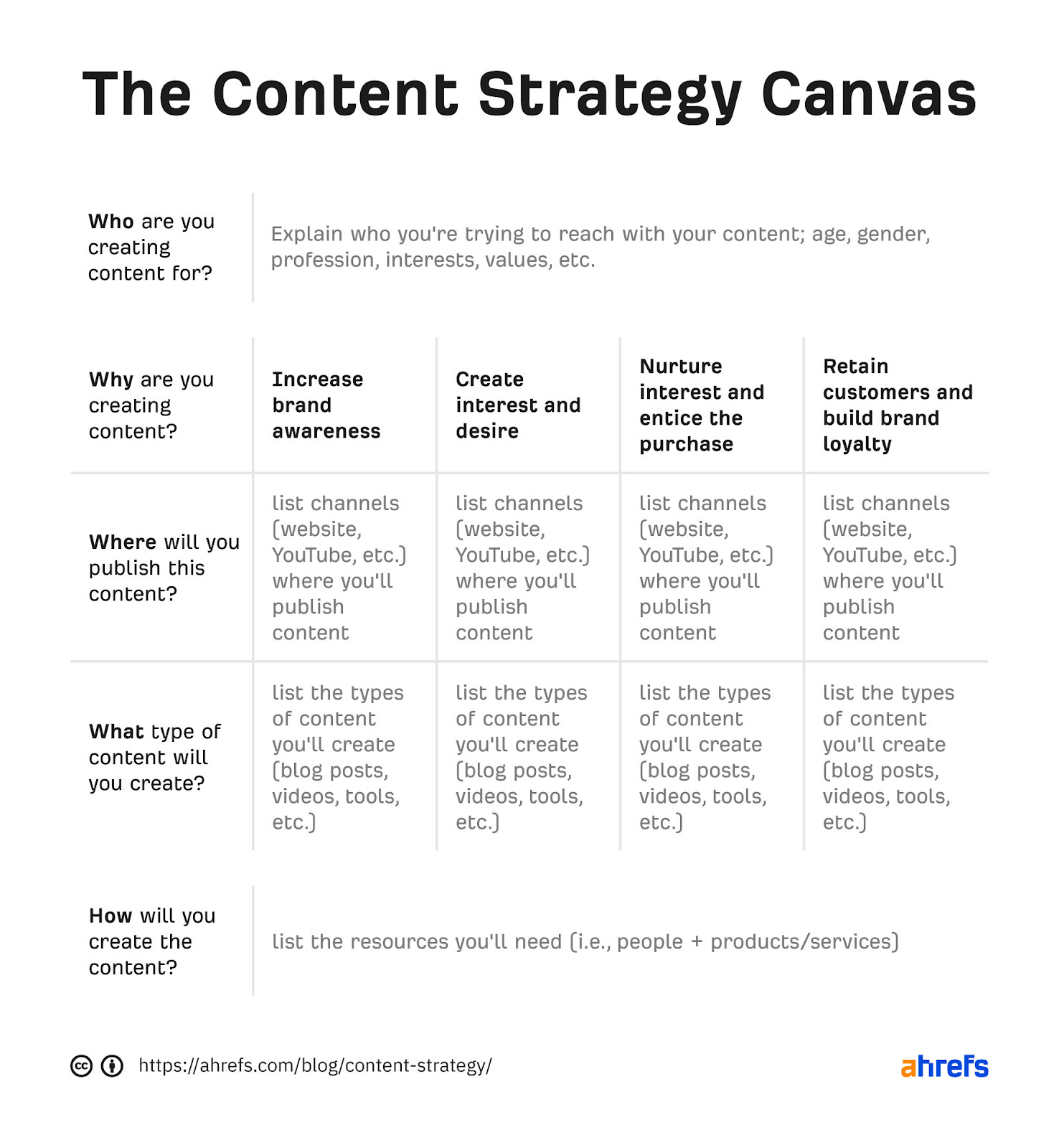
Completing the content strategy canvas should set you on the right path to creating content that will improve your business. However, don’t forget to promote your content too.
Promoting content means not waiting for your target audience to discover your content. Instead, it’s about actively putting the content in front of them. Follow the checklist in this post or this video to get more eyeballs on your content:
Recommended reading: Content Marketing: A Comprehensive Guide
Pay-per-click (PPC) marketing is a form of online advertising where advertisers pay a fee each time someone clicks their ad.
Search engine ads are the most common ad format in PPC marketing. Other formats include display ads on websites and social media ads, such as those you see on Facebook, Instagram, and YouTube.
How to do it
You’ll first need to choose a platform you want to advertise on. You should only pay for ads on platforms where your audience exists. For example, if you’re selling enterprise software to C-level executives, you may not want to advertise on TikTok. (Of course, if you have data showing these execs in your industry are on TikTok often, then it makes sense to advertise there.)
After that, you should get familiar with the platform. Explore the ad platform by clicking around or take a course. These platforms typically offer educational resources to help you learn how to run ads (here’s one from Google).
Ads can succeed or fail based on your targeting, so make sure you have data to back up your targeting choices. For example, if you’re running search ads, you’ll need to do keyword research. You’ll need to know what people search for and then how much you’ll be paying for clicks on average.
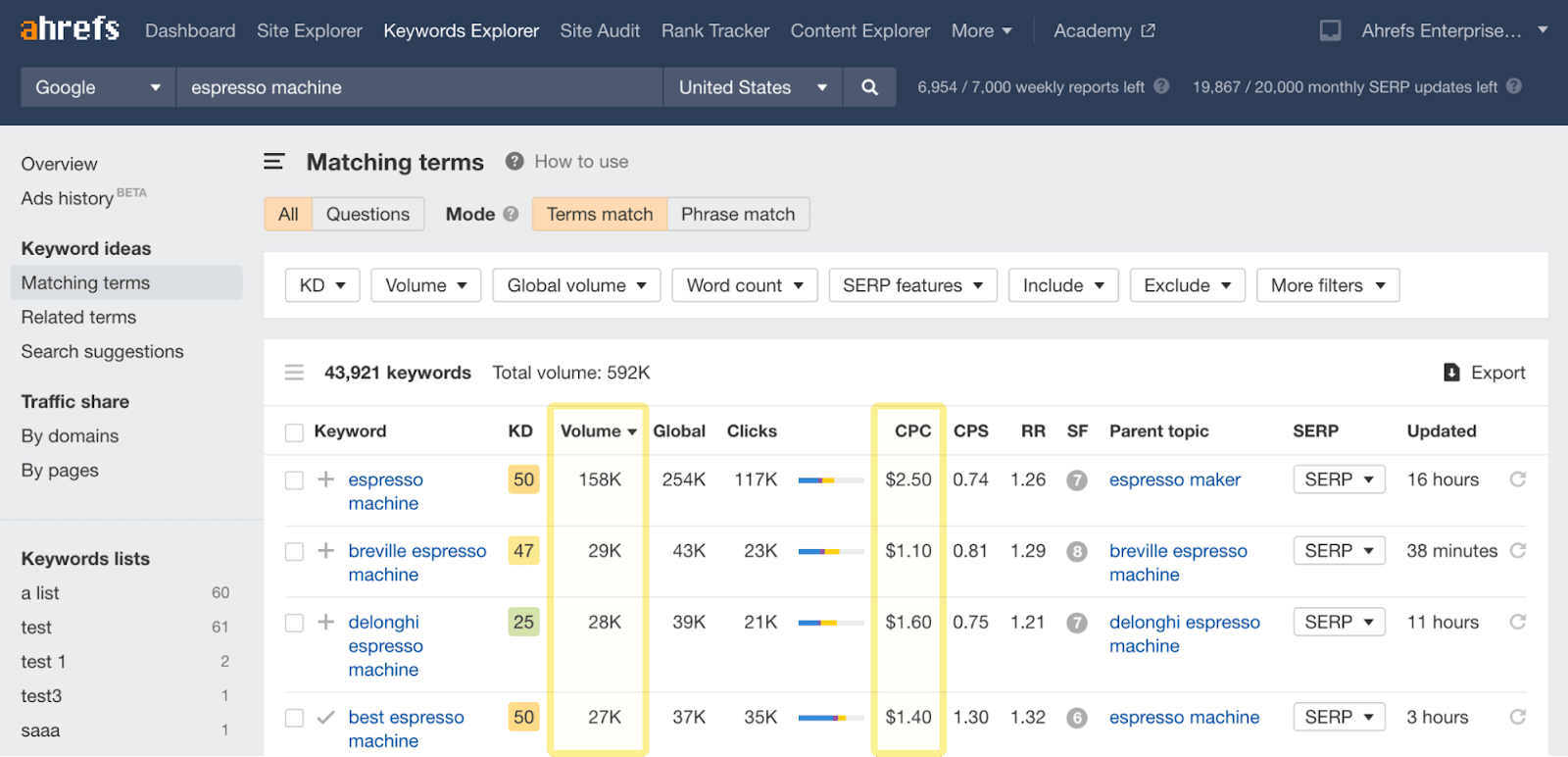
You should also make sure you’ve set up your tracking properly.
Budget-wise, decide on a daily budget that won’t make a big dent in your overall marketing budget and start with that. Monitor and optimize your campaigns regularly. Once you start getting solid results, you can increase your budget.
Finally, creatives and copy matter too in PPC marketing. Make sure you’re constantly experimenting with different images, videos, headlines, body copies, and more to see what resonates with your audience!
Recommended reading: PPC Marketing: Beginner’s Guide to Pay-Per-Click Ads
Email marketing is any kind of marketing messaging done through the channel of email.
How to do it
Email marketing doesn’t just involve sending emails. It also includes:
- Building an email list.
- Designing, writing, and sending emails to the subscribers on your list.
- Segmenting the list.
- Deciding when to send the email.
- Monitoring the results.
- Curating the email list.
To begin, you’ll need a list of email addresses to send messages to. The easiest way to build this list is to offer an incentive to website visitors in return for subscribing. For example, e-commerce stores tend to offer discount coupons, such as what Frank Body does:

You’ll also need to decide what kind of emails you want to send to your subscribers. At the basic level, you should have a welcome email with the incentive you promised earlier. In Frank Body’s case, its first email features the 10% discount code.
But what should you send from that point onward? Unfortunately, there’s no clear-cut “right” answer. It’ll take a mix of intuition and experimentation to figure out what’s best.
For example, here’s an illustration of a potential email marketing workflow.
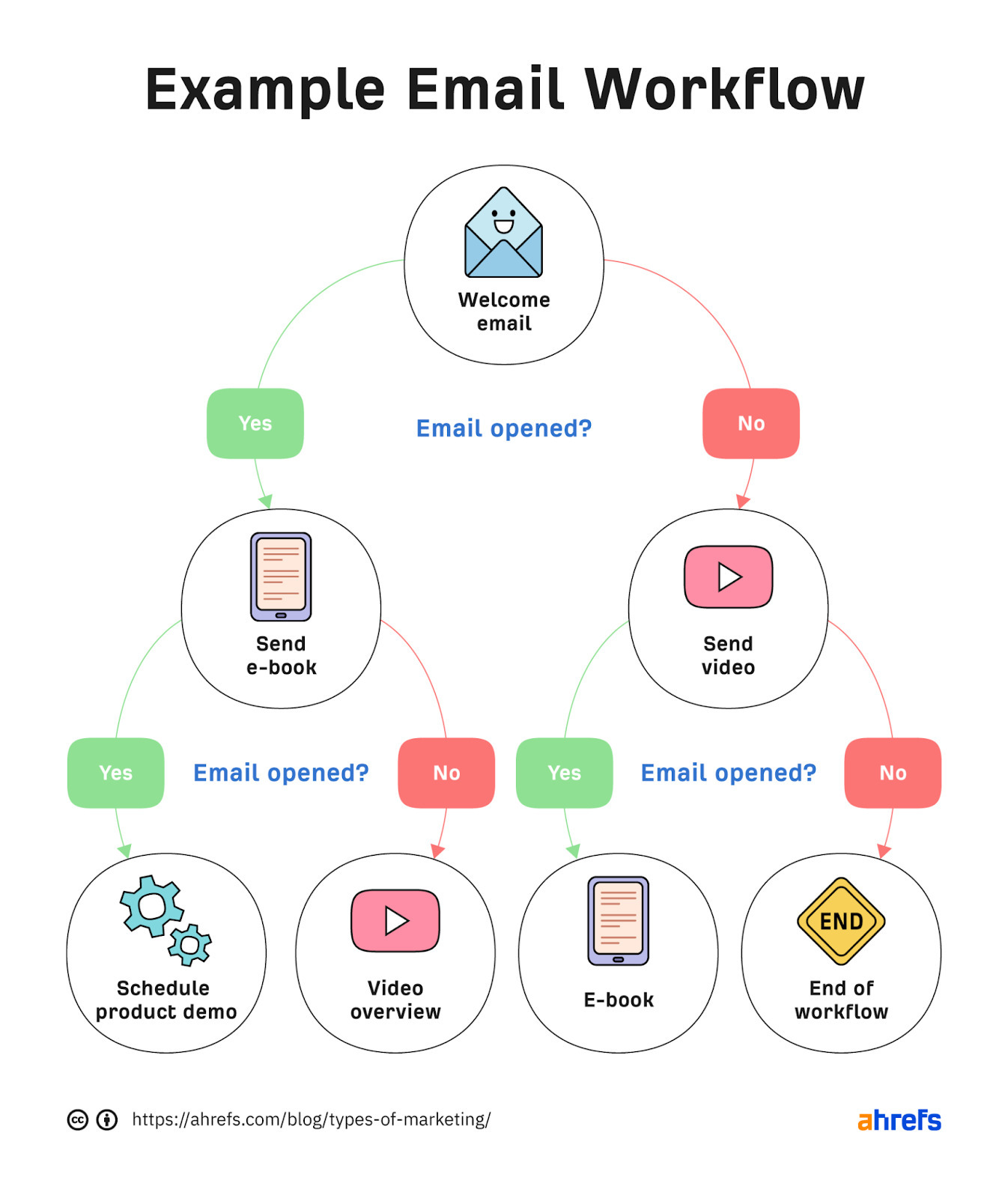
Even this sample workflow is pretty complex. There are many elements to get right. For us at Ahrefs, we keep things simple—we promise a weekly newsletter, and that’s all we send:
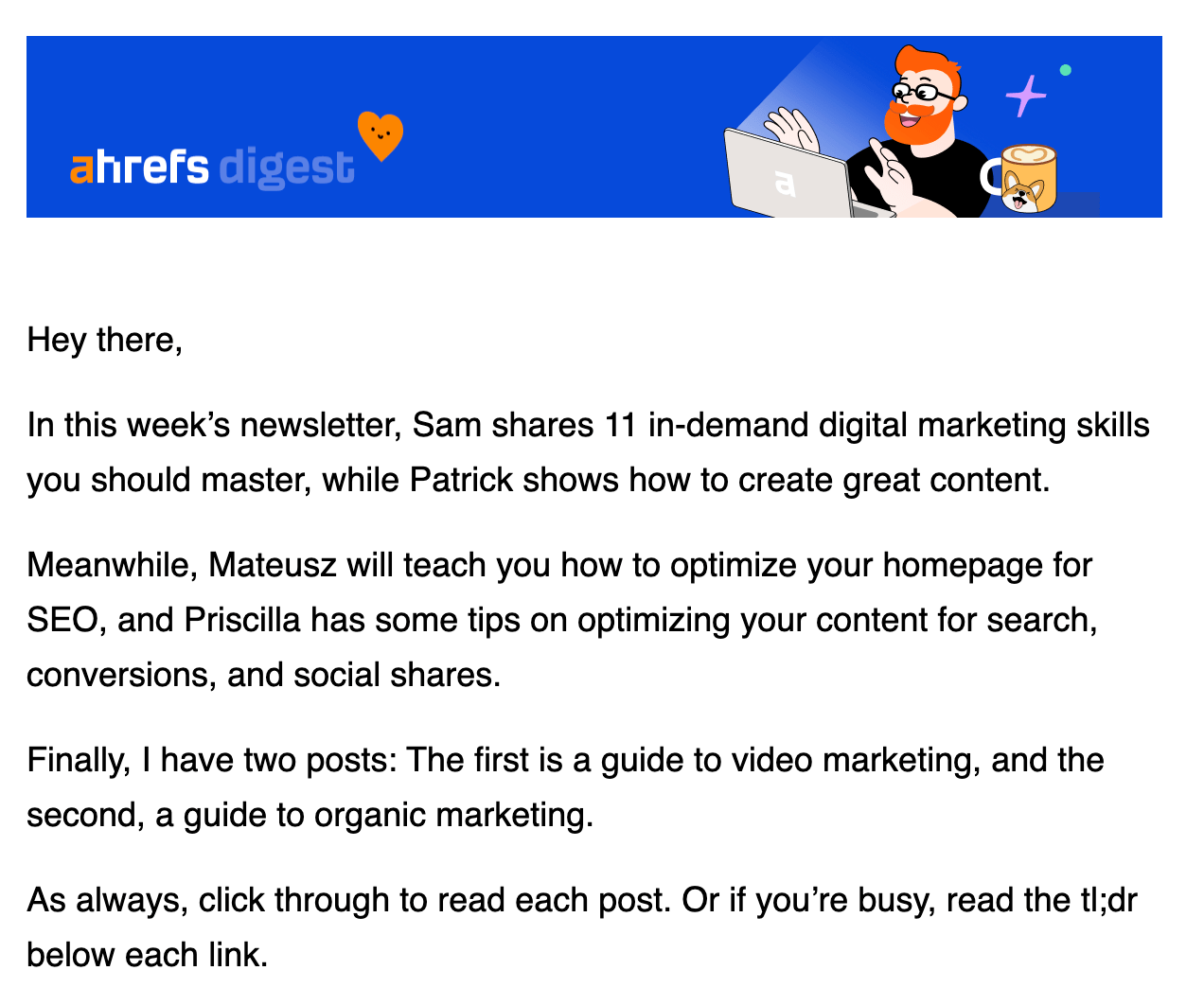
Recommended reading: The Ultimate Guide to Email Marketing
Affiliate marketing is where other people promote your products in return for a commission. For example, if your product costs $100, you can pay an affiliate $10 for each sale they generate for you.
How to do it
You’ll first need to create an affiliate program that people can sign up for. This gives them a unique link they can use to promote your product and track the sales they generate.
Then you’ll need to look for people who may want to promote your product.
The easiest way is to look for people who are already promoting competing products.
Here’s how:
- Go to Ahrefs’ Site Explorer
- Enter the domain of a competing product
- Go to the Backlinks report
- Look for an affiliate footprint in the URL
For example, many of the backlinks to bluehost.com go to URLs with /track/ in them:

These are most likely affiliate links, so we can find all the websites promoting this product by filtering for backlinks with this footprint (/track/) in the target URL and toggling “One link per domain”:
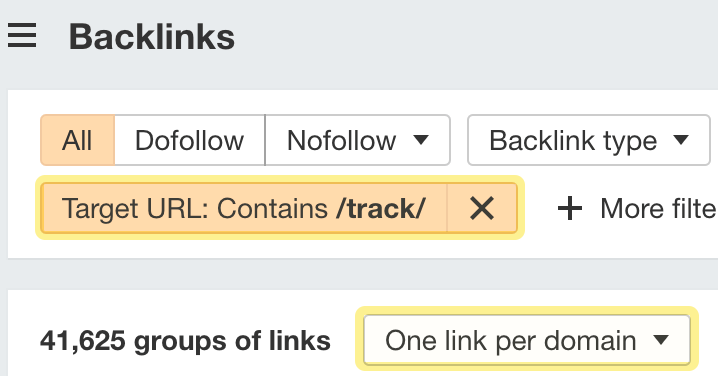
Recommended reading: How to Create a Successful Affiliate Program for Your Business
Influencers are people who have an active, sizable audience (usually on social media) and the ability to influence their audience to do something.
Influencer marketing is the practice of working with influencers to promote your brand’s messages, products, or services.
View this post on Instagram
How to do it
The easiest way to find influencers is to use existing third-party tools. And there are different tools for the different social media platforms. Here’s a list to look through:
- Followerwonk (Twitter)
- Influenx (YouTube)
- Heepsy (Instagram, YouTube, TikTok, Twitch)
- inBeat (TikTok, Instagram)
- Intellifluence (Reddit, SoundCloud, podcasts, Amazon reviews, iOS and Android reviews, Twitch, LinkedIn, Facebook, Pinterest, Instagram, YouTube, Twitter, TikTok)
- Grin (Twitch, Facebook, Instagram, YouTube, Twitter, TikTok)
- Influence.co (Facebook, Pinterest, Snapchat, Instagram, YouTube, Twitter, blogs)
- HypeAuditor (Instagram, TikTok, YouTube, Twitter, Twitch)
When you’ve gathered a list of influencers, don’t reach out just yet. Since social platforms can be gameable, some of these influencers may have tons of fake followers. A certain percentage of fake followers is inevitable, but you don’t want them to be a significant percentage of those influencers’ following.
A quick way to check is to use a tool like SparkToro’s Fake Followers Audit (Twitter only) or HypeAuditor’s Instagram Audit.
Beyond the quantity of following, you’ll want to make sure the quality of engagement exists too. If an influencer has a lot of followers but barely gets any comments on their posts, it’s a potential red flag.
The absolute number of likes, comments, retweets, etc., doesn’t matter either. Quality does. Look out for genuine comments or conversations. If an influencer posts something and the comments look like these…

… then that’s a potential red flag.
Once you’ve narrowed down the list to those influencers with the amount of reach and resonance you want and made sure that the influencers’ image and reputation represent your brand well, reach out and ask to collaborate.
Recommended reading: Influencer Marketing: Definition, Examples, and Tactics
Video marketing is using videos to promote and educate your target audience. It’s also used to increase brand awareness and social engagement, allowing you to reach new and bigger audiences.
How to do it
To begin, you need to know what kind of videos you want to create. There are three main objectives for video marketing: brand awareness, education, or entertainment.
If your goal is to create videos for brand awareness or entertainment, then the good and bad news is there is no template. It all boils down to your creativity.
If your goal is to create educational content, then you can do keyword research to see what kind of topics or questions people are searching for on YouTube.
Here’s how:
- Go to Ahrefs’ Keywords Explorer
- Switch the tab to YouTube
- Enter a relevant keyword or keywords
- Go to the Matching terms report
- Switch the tab to Questions

Once you’ve picked out the topics you want to target, create a video that’ll rank for them on YouTube. Watch this video to learn how:
Recommended reading: The Simple (But Complete) Guide to Video Marketing
Social media marketing is the use of social media like Facebook, Twitter, or LinkedIn to market a company’s products or services.

How to do it
To begin, you’ll want to have a presence on major social platforms like Facebook, Instagram, Twitter, YouTube, and LinkedIn. Even if you’re not going to be active on those platforms, having a page or brand account offers legitimacy and also protects your brand account from potential squatters.
Social media is all about content. To build a following and gain engagement, you’ll need to post frequently. Understandably, being active on so many different social media platforms can be difficult if you are resource-stretched.
On a basic level, you should be active on the standard social networks: Facebook, LinkedIn, and Twitter.
So if you’re already creating content, you can always share those articles, videos, or podcasts on your social media pages. For example, all we do on our Facebook page is share our newly published content:
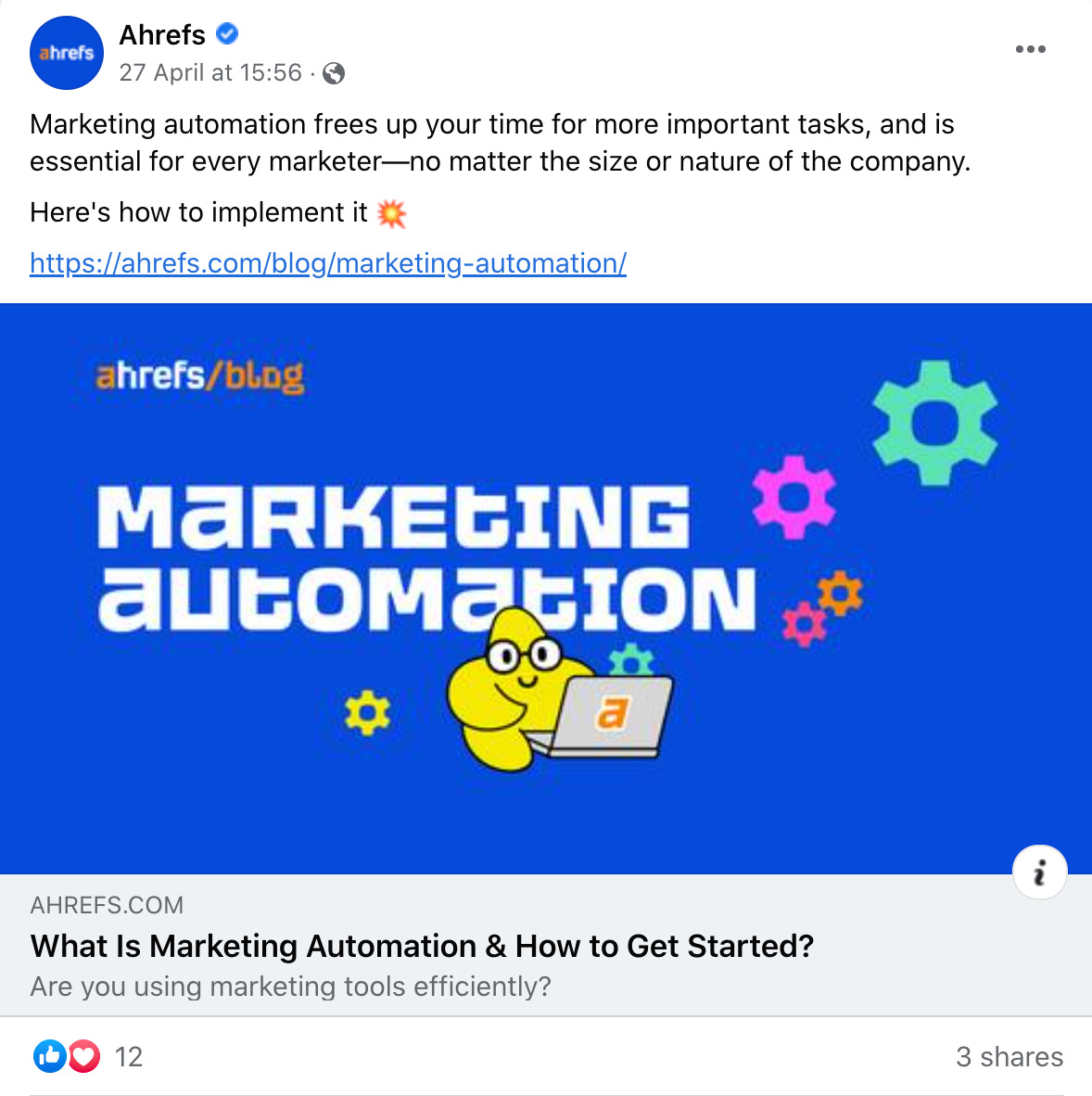
Furthermore, you can always repurpose content on social media. In fact, that’s what we do all the time.
For example, this tweet is an image from our article on doing a content audit:
Conducting a content audit in 2022? Use this flowchart to guide you 💥 pic.twitter.com/S2h45DiH1z
— Ahrefs (@ahrefs) April 19, 2022
If there’s a platform you want to invest further in, consider creating custom content for it. Watch how other brands and influencers craft their content, and you’ll get an idea of what works and what doesn’t.
Experimentation is the name of the game. Following tried-and-tested formats is a good idea, but don’t be afraid to try new things.
That was how Wendy’s did it, with a completely different tone, format, and identity compared to other brands at that time. (If you see brand accounts being funny or sarcastic today, you can credit it to Wendy’s.)
Podcasting is a type of content marketing that focuses on producing audible content. It is great for brand-building and growing an audience.
How to do it
There are two major strategies when it comes to podcasting:
- Start your own podcast
- Appear on someone else’s podcast
Starting a podcast is an entire topic on its own, so I’ll leave links to resources that you can consume:
At Ahrefs, we do have experience appearing on podcasts. In fact, our chief marketing officer, Tim Soulo, once set a goal to appear on 20 podcasts in a year and succeeded.
To appear on podcasts, you need a list of podcasts to be a guest on. Besides Googling for the top industry podcasts, one way to find them is to look for someone in your niche who’s already appearing on them.
Here’s how:
- Find someone notable in your niche who has been appearing on podcasts
- Enter their domain into Ahrefs’ Site Explorer
- Set the mode to Exact URL
- Go to the Backlinks report

Sift through the results for relevant podcasts in your niche. When you have a list, pitch to the shows.
Pitching is pretty straightforward. You either follow a show’s application process…
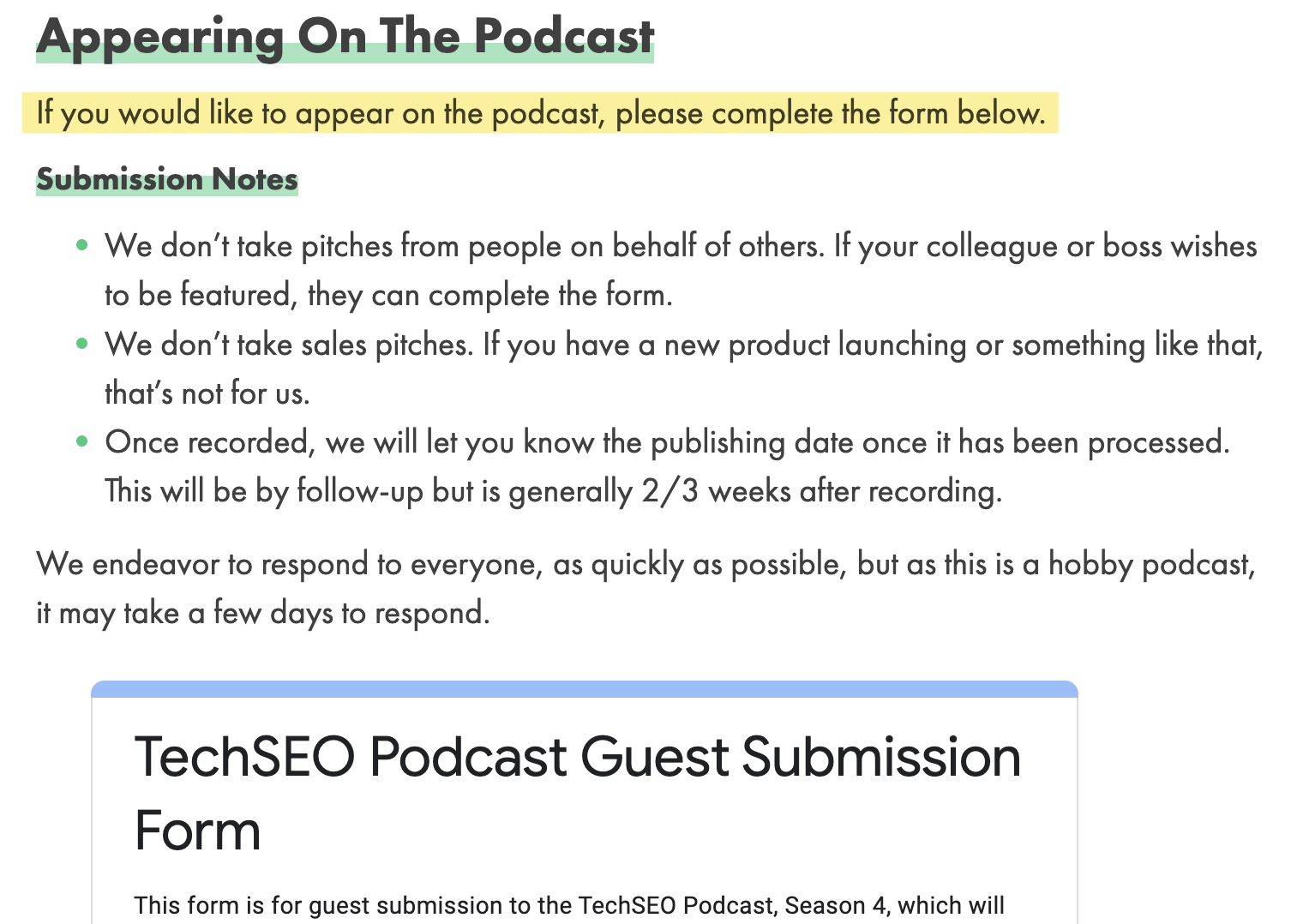
… or reach out by email and pitch yourself as a guest. First, find the email address. Then in your pitch, try to cover the three Ws:
- Who? Explain who you are, who you work for, etc
- Why? Explain why you’ll be a good podcast guest, i.e., sell yourself
- What? Explain what you want to talk about
Recommended reading: How to Use Podcasts for Link Building
A conversion is when a website visitor takes an action you want them to take on your website. So conversion rate optimization (CRO) is the process of optimizing your website or its pages to improve or encourage more of the actions you want visitors to take.
How to do it
Like SEO, CRO is not one and done. You can always optimize more. So rather than being one-off hacks you apply to your website, CRO is a systematic process informed by data.
As CRO expert Brian Massey puts it, CRO is “about meaningful tests backed by thorough conversion research and executed using a disciplined, step-by-step process.”
It involves understanding user psychology, user experience (UX) and user interface (UI) design, copywriting, persuasion, running A/B tests, statistics, understanding and analyzing data, and more.
Here’s a simplified example of what CRO may look like. Let’s say we want to improve the conversion rate of the Ahrefs Webmaster Tools page. That is, we want more people who visit the page to sign up for AWT.

To do that, we may want to systematically A/B test things like:
- The page design.
- The headline.
- The sub-headline.
- The call-to-action (CTA) button.
- Social proof (e.g., testimonials, case studies, etc.).
And more.
A note to bear in mind, though: For your A/B tests to be statistically significant (i.e., prove you can attribute any increase or decline to the change you made and that the change is not by chance), you’ll need a significant amount of traffic coming to your website.
So while CRO is important, it’s not something you do right from the get-go. Focus on using the other internet marketing strategies to drive more traffic to your website first before you even consider running split tests.
Recommended reading: Conversion Rate Optimization Guide by CXL
Online reputation management (ORM) is the practice of using digital marketing tactics and channels to help shape the public perception of a brand, an organization, or an individual online.
How to do it
Reputation management includes many different activities. For example, it may involve using social media to jump in on conversations and tackle negative or unhappy comments about your company.
Sorry for the inconvenience caused, Alan! And thanks for your patience. 🙏
— Ahrefs (@ahrefs) April 20, 2022
By acknowledging the source of unhappiness and listening to the customer, we were able to deflect anger and improve our relationship with him.
But it’s not just about social media. You can do reputation management in search engines too. For example, you may find articles ranking high on Google that speak negatively about your brand or perpetuate a misconception.
If it’s something you can correct, you should try to nip it in the bud.
Here’s how to find such articles:
- Go to Ahrefs’ Content Explorer
- Search for your brand name and exclude your own site [
-site:yourdomain.com] - Set a Page traffic filter to something high (e.g., 1,000+ visits per month)

For example, we found a post by HubSpot about the best digital marketing tools. Even though it is a huge compliment about our toolset (thanks, HubSpot!), it mentions something inaccurate about our data:

Instead of “150 million keywords” in the U.S, we actually have 4.4 billion keywords. And instead of 150 countries, we have more than 200.
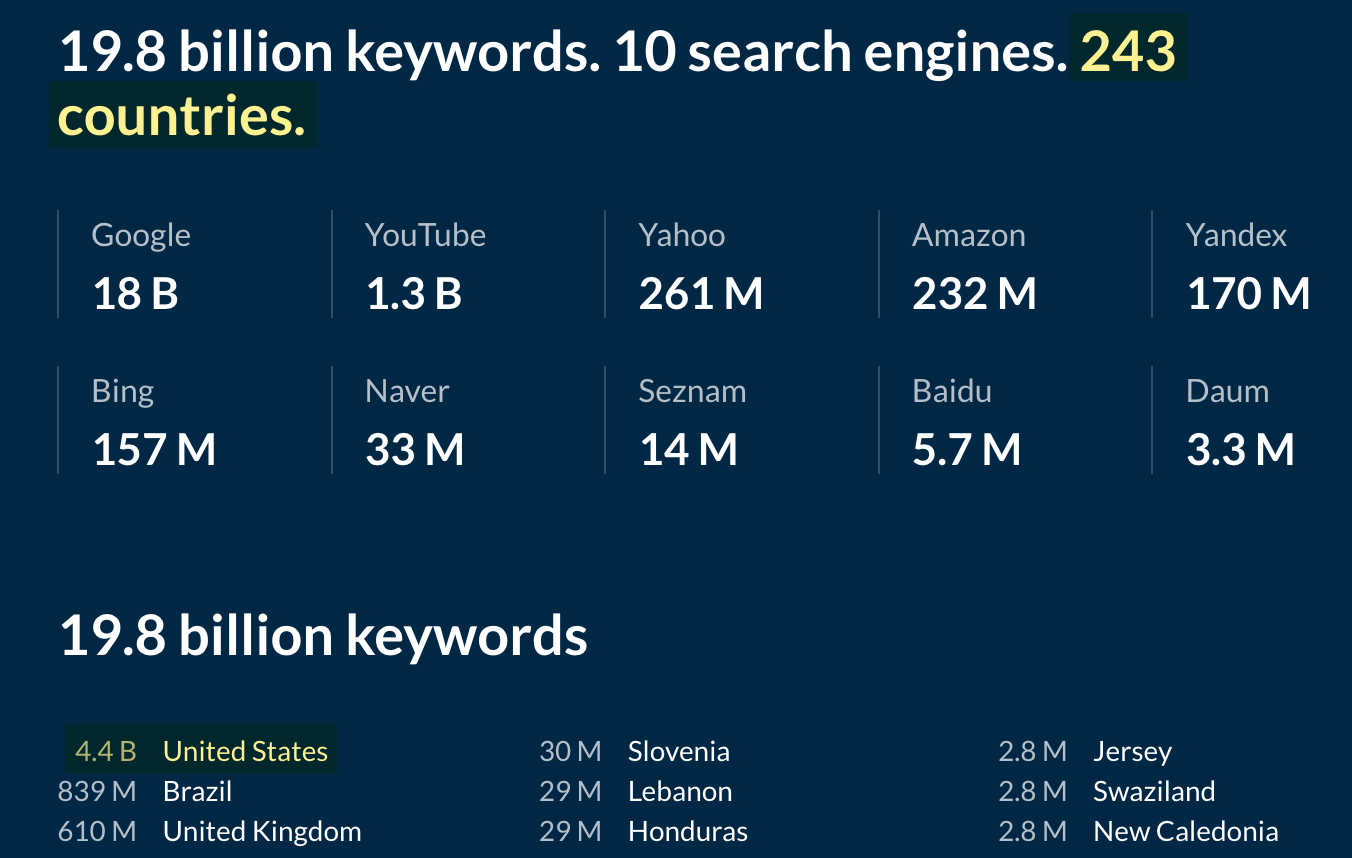
Plus, the screenshot of our UI it featured is outdated.
We’re proud of our data, and the ones mentioned by HubSpot are way off from our current state. And it may set up wrong or different expectations from users who discover us via this article.
In this case, we can reach out and ask HubSpot or the author to update these metrics.
Recommended reading: A 5-Step Online Reputation Management Guide (That ANYONE Can Follow)
Final thoughts
This list of internet marketing strategies is by no means exhaustive. But it should have educated you on some of the more popular and timeless ones.
When executed correctly, the strategies work and will continue to work.
Did I miss out on any important internet marketing strategies? Let me know on Twitter.




